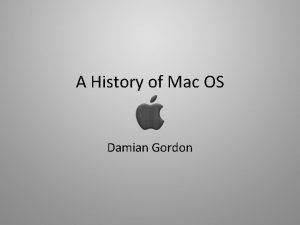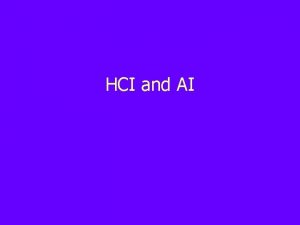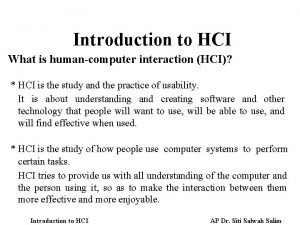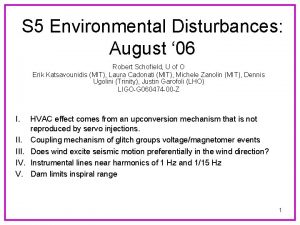HCI 500 Introduction to HCI DAMIAN SCHOFIELD HCI





















- Slides: 21

HCI 500 : Introduction to HCI DAMIAN SCHOFIELD

HCI 500: Introduction to HCI • Fitts’s Law • Definition • Calculation • Dimensionality • Edges • Applications • Problems • Quiz

HCI 500: Introduction to HCI • Fitts’s Law • Definition • Calculation • Dimensionality • Edges • Applications • Problems • Quiz

Human-Computer Interaction Interface Design Interface design is difficult in part because everything requires interpretation.

Human-Computer Interaction Interface Design Interface design is difficult in part because everything requires interpretation. A design that works for one task or one user might not be appropriate for another. In other types of engineering, like architecture or bridge building, designers can always rely on laws of physics and gravity to make designs work.

Human-Computer Interaction Interface Design There is, however, at least one immutable rule for interface design that we know about, and it's called Fitts's Law. It can be applied to software interfaces as well as Web site design because it involves the way people interact with mouse or other pointing devices.

Human-Computer Interaction Interface Design There is, however, at least one immutable rule for interface design that we know about, and it's called Fitts's Law. It can be applied to software interfaces as well as Web site design because it involves the way people interact with mouse or other pointing devices. Most Graphical User Interface (GUI) platforms have built-in common controls designed with Fitts's Law in mind. Many Web designers, however, have yet to recognize the powerful little facts that make this concept so useful.

Human-Computer Interaction Fitts’s Law In 1954 a psychologist named Paul Fitts of Ohio State University and later the University of Michigan developed a model of human movement based on rapid, aimed movement.

Human-Computer Interaction Fitts’s Law In 1954 a psychologist named Paul Fitts of Ohio State University and later the University of Michigan developed a model of human movement based on rapid, aimed movement. It makes sense that response time would be affected by the distance moved and the precision demanded by the size of the target to which one is moving. To investigate this relationship Fitts conducted experiments in which target distance and width were varied.

Human-Computer Interaction Reciprocal Tapping In this experiment, subjects were asked to tap a stylus back and forth between two metal plates while their time was recorded. If they tapped a side plate instead of the target center plate an error was recorded. The subjects were also told to emphasize accuracy rather than speed.

Human-Computer Interaction Fitts’s Law Fitts’s law applies to any interface device – for example a mouse …

Human-Computer Interaction Fitts’s Law The basic idea in Fitts's Law is that any time a person uses a mouse to move the mouse pointer, certain characteristics of objects on the screen make them easy or hard to click on.

Human-Computer Interaction Fitts’s Law The basic idea in Fitts's Law is that any time a person uses a mouse to move the mouse pointer, certain characteristics of objects on the screen make them easy or hard to click on. ? ? ?

Human-Computer Interaction Fitts’s Law The basic idea in Fitts's Law is that any time a person uses a mouse to move the mouse pointer, certain characteristics of objects on the screen make them easy or hard to click on. 1. The farther the person has to move the mouse to get to an object, the more effort it will take to get to. 2. The smaller the object is, the harder it will be to click on.

Human-Computer Interaction Fitts’s Law The basic idea in Fitts's Law is that any time a person uses a mouse to move the mouse pointer, certain characteristics of objects on the screen make them easy or hard to click on. 1. The farther the person has to move the mouse to get to an object, the more effort it will take to get to. 2. The smaller the object is, the harder it will be to click on. Pretty simple, right?

Human-Computer Interaction Fitts’s Law It means that the easiest objects to locate and target are the ones closest to the mouse's current position and that have large target spaces.

Human-Computer Interaction Fitts’s Law It means that the easiest objects to locate and target are the ones closest to the mouse's current position and that have large target spaces. Fitts wrote several papers describing these findings, with significant mathematical rigor, expressing in formulas how you can measure the impact of different velocities, distances, and target sizes on a user's ability to click on objects.

Human-Computer Interaction Fitts’s Law It means that the easiest objects to locate and target are the ones closest to the mouse's current position and that have large target spaces. Fitts wrote several papers describing these findings, with significant mathematical rigor, expressing in formulas how you can measure the impact of different velocities, distances, and target sizes on a user's ability to click on objects. The worst possible object is one that is very far away from the current position of the cursor, and very small in size.

Human-Computer Interaction Fitts’s Law It means that the easiest objects to locate and target are the ones closest to the mouse's current position and that have large target spaces. Fitts wrote several papers describing these findings, with significant mathematical rigor, expressing in formulas how you can measure the impact of different velocities, distances, and target sizes on a user's ability to click on objects. The worst possible object is one that is very far away from the current position of the cursor, and very small in size. Again, pretty simple, right?

Human-Computer Interaction Fitts’s Law “Although the basic message is obvious (big things are easier to select) it is the precise mathematical characterization that is exciting, and that this characterization includes a logarithmic function which means that the shape of the relationship between size and reaction time is curved so that small increases in size for small objects make it much easier to select them (whereas small increases in size for big objects don’t make that much difference). And the same applies for changes in target distance. ” Stafford, T. and Webb, M. , Mind Hacks: Tips & Tricks for Using Your Brain, O'Reilly Media, 2004.

Human-Computer Interaction
 3,500/500
3,500/500 Damian sturzaker
Damian sturzaker Padre damian de veuster 2215 vitacura
Padre damian de veuster 2215 vitacura Padre damian de veuster 2215
Padre damian de veuster 2215 Padre damian de veuster 2215 vitacura
Padre damian de veuster 2215 vitacura Damian clancy
Damian clancy Damian krysztofik
Damian krysztofik Dr damian folch
Dr damian folch Damian urbańczyk żona
Damian urbańczyk żona Christophe damian
Christophe damian Damian mac
Damian mac Damian gordon
Damian gordon Fray damian massanet picture
Fray damian massanet picture Padre damian de veuster 2215 vitacura
Padre damian de veuster 2215 vitacura Padre damian de veuster 2215
Padre damian de veuster 2215 Damian harding
Damian harding Php podstawy
Php podstawy Damian topolski
Damian topolski Oscar sandoval md
Oscar sandoval md Damian heywood
Damian heywood Melissa damian
Melissa damian стивен марли muzičar
стивен марли muzičar








































